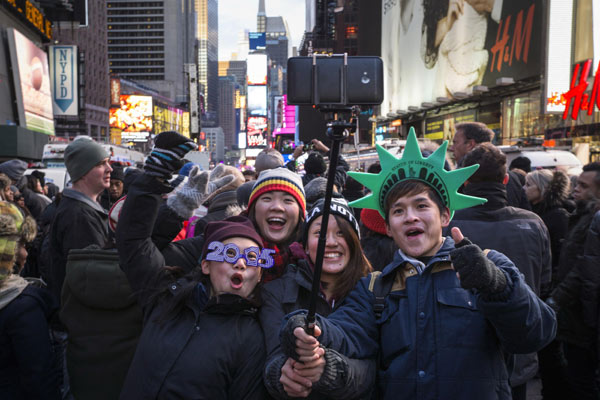Sticking it to the selfie stick
By AMY HE in New York (chinadaily.com.cn) Updated: 2015-03-20 09:36
 |
|
A boy (left) wears 2015 glasses as a group of family members use a selfie stick to photograph themselves during New Year's Eve celebrations in Times Square, New York December 31, 2014. Zoran Milich / REUTERS |
Museums in China are already doing it, and some museums in the United States have done it or are considering it: banning the selfie stick.
The apparatus - an extendable pole on which a user can set a smartphone to take photos - has become one of the most popular tech accessories for tourists, and museums are banning them out of concern for the safety of other museum goers and artifacts.
"We do not allow selfie sticks, for safety and security reasons," said Rebecca Baldwin, spokeswoman for the Art Institute of Chicago. "We believe they are potentially harmful to works of art and to patrons in the galleries."
The Art Institute's ban has been in place since January, she said.
The J. Paul Getty Museum in Los Angeles has a similar ban, and considers the selfie stick in a category similar to camera tripods and mounts. They are permitted on the grounds of the museum, but are not permitted in the galleries, according to Julie Jaskol, assistant director of media relations at the museum.
"We don't allow any umbrellas in the gallery either, or anything long and pointy would be a no-go," Jaskol told China Daily. The selfie stick has never been allowed in the galleries.
"We have a general policy against tripods and monopods for similar safety reasons; we don't want anybody or anything to get hurt," said Mikaela Pollock, marketing manager at the Getty.
The Museum of Modern Art in New York also has the ban, a spokeswoman said. The Metropolitan Museum of Art is considering the same ban, according to the Telegraph of London.
In New York, selfie sticks are available for purchase in drugstores and in newspaper stands around the city. On Amazon.com, some selfie sticks can be purchased for under $10. They average about 3.5 feet when extended.
The Hirshhorn Museum and Sculpture Garden in Washington prohibits the use of the tech accessory as well, citing concerns for the "safety of the artwork and the visitors who come to enjoy it," according to the Washington Post.
The Smithsonian museums in Washington also have a similar ban.
Selfie sticks have become enormously popular in China, and Chinese museums have been making suggestions to visitors that selfie sticks not be used, with some banning them and some considering bans.
Beijing's Palace Museum said that they are "not suggested to be used" within the institution because there are narrow corridors and passageways, and that the camera extension sticks may cause damage.
"Selfie sticks will cause safety concerns, whether for tourists or the exhibits," said Shen Lixia, deputy director of the tourist reception department. "It may touch the glass exhibition case and cause damage to the cultural relics." Similarly, the Nanjing Museum prohibits use of the stick within the museum's premises, but they are still allowed. Like other US museums, the Nanjing Museum groups the selfie stick under the same category as camera tripods and monopods, which are also prohibited.
Across Europe, various cultural institutions have prohibited the gadget as well: the National Gallery in London, the Palace of Versailles in Paris, and the Roman Colosseum have all announced this year that selfie sticks are not to be used, according to the Associated Press.
Wang Kaihao contributed to this story.
- Should selfie sticks be banned?
- Selfie sticks on way to being banned
- Palace Museum tells visitors to put selfie sticks away
- Smile, you're part of a giant 'selfie' record attempt
- Chinese museums say ‘no’ to selfie sticks
- Season of selfie at two sessions
- Baby 'delegate' and selfie stick at two sessions






